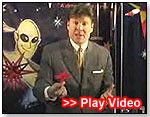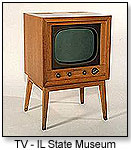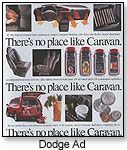
April 2, 2025

May 2008 | Vol. VII - No. 5
Yesterday's Marketing is Dead: Part 2
”Marketing Equation” Offers Relief to Old Ads
| “Since the 1990s, marketers have been struggling to overcome the buyer’s confidence gap.” — Charles Allen |
The reason most strategic advertising and marketing does not work today is that most companies’ inside reality and outside perception do not match. It doesn't matter how wonderful your features or benefits are if nobody notices you or hears what you're saying.
 This disconnect exists because today's marketers — all 10 zillion of them; not the mere handful that dominated the three television channels of yesterday — are all saying virtually the same thing.
This disconnect exists because today's marketers — all 10 zillion of them; not the mere handful that dominated the three television channels of yesterday — are all saying virtually the same thing.
GOING BACK
In the late 1800s and early 1900s, advertisements were thought of as an army of salespeople, all armed with the perfect presentation and not afraid of “no.” It was a time when:
— Headlines identified problems (e.g., “Triumph Over Headaches”).
— Copy educated the buyer and sought to build a case.
— Offers gave prospects a low-risk way to learn more.
 In 1948, television changed marketing forever. Ads shrank from one to two minutes down to 30 seconds. Ad prices went up drastically, and only the largest companies could afford to compete. Slogans became the most cost-effective way to communicate, and creativity and repetition (C & R) became the defacto standard: "Pop, Pop, Fizz, Fizz. Oh, What a ______ it is."
In 1948, television changed marketing forever. Ads shrank from one to two minutes down to 30 seconds. Ad prices went up drastically, and only the largest companies could afford to compete. Slogans became the most cost-effective way to communicate, and creativity and repetition (C & R) became the defacto standard: "Pop, Pop, Fizz, Fizz. Oh, What a ______ it is."
In the era of the brand builders, inside reality and outside perception didn't have to match because few companies could afford to play, and those companies won by default. Many radical transformations forced business practices to evolve in the next 60 years, but advertising and marketing largely did not.
The days of simple selling, in which the seller had the power, lasted until the 1980s. During this era, there were fewer competitors, fewer choices, lower education levels, less information, little technology and low resistance, making it dramatically easier to make a buying decision.
 Since the 1990s, marketers have been struggling to overcome the buyer’s confidence gap, which represents the buyer’s inability to distinguish whether businesses, products or services from one company are any better, different or worse than those from another company. In an environment of increased technology, hyper-competition, longer buying cycles and an almost infinite number of choices, the buyer has the power, and the seller is at his or her mercy.
Since the 1990s, marketers have been struggling to overcome the buyer’s confidence gap, which represents the buyer’s inability to distinguish whether businesses, products or services from one company are any better, different or worse than those from another company. In an environment of increased technology, hyper-competition, longer buying cycles and an almost infinite number of choices, the buyer has the power, and the seller is at his or her mercy.
TODAY’S ADS
Most of today's advertisements fit into two categories. The first, institutional ads, are used by larger companies, supported by huge budgets. Normally, they smack of: “Here's our best attempt at being creative and here's the biggest budget we could muster to support this rubbish.”
The second, menu-style ads, are just like restaurant menus: “Here's our name along with a list of stuff we'd like to sell you.” Commonly found in newspapers, magazines, online and sometimes on radio and television, these ads extend a basic offer and are normally used by smaller companies.
 Just because some ads are poorly designed and constructed doesn't mean they won't work. Sometimes companies’ competitors are not doing any better at marketing than they are, so anyone with an ad will get some business. These situational results accrue to businesses that simply subsist off of market momentum alone. This dynamic is akin to a dead fish floating downstream.
Just because some ads are poorly designed and constructed doesn't mean they won't work. Sometimes companies’ competitors are not doing any better at marketing than they are, so anyone with an ad will get some business. These situational results accrue to businesses that simply subsist off of market momentum alone. This dynamic is akin to a dead fish floating downstream.
Countless case studies on marketers who applied the marketing equation to their strategic marketing message reveal that response rates increased hundreds of percentage points. On the exact same investment of money, time and effort, by simply changing what was said and how it was said, marketers were able to multiply results exponentially.
In the case of one regional bank, response rates soared by over 465 percent! This is the epitome of leveraging marketing's momentum, and it begins with eliminating platitudes, which we’ll discuss in the next and final installment of this series, where we’ll also talk over the marketing equation itself.
Videography and editing by Alison Marek. Sound by Joe Fiorello.
Copyright © 2025 TDmonthly®, a division of TOYDIRECTORY.com®,
Inc.



 This disconnect exists because today's marketers — all 10 zillion of them; not the mere handful that dominated the three television channels of yesterday — are all saying virtually the same thing.
This disconnect exists because today's marketers — all 10 zillion of them; not the mere handful that dominated the three television channels of yesterday — are all saying virtually the same thing.  In 1948, television changed marketing forever. Ads shrank from one to two minutes down to 30 seconds. Ad prices went up drastically, and only the largest companies could afford to compete. Slogans became the most cost-effective way to communicate, and creativity and repetition (C & R) became the defacto standard: "Pop, Pop, Fizz, Fizz. Oh, What a ______ it is."
In 1948, television changed marketing forever. Ads shrank from one to two minutes down to 30 seconds. Ad prices went up drastically, and only the largest companies could afford to compete. Slogans became the most cost-effective way to communicate, and creativity and repetition (C & R) became the defacto standard: "Pop, Pop, Fizz, Fizz. Oh, What a ______ it is." Since the 1990s, marketers have been struggling to overcome the buyer’s confidence gap, which represents the buyer’s inability to distinguish whether businesses, products or services from one company are any better, different or worse than those from another company. In an environment of increased technology, hyper-competition, longer buying cycles and an almost infinite number of choices, the buyer has the power, and the seller is at his or her mercy.
Since the 1990s, marketers have been struggling to overcome the buyer’s confidence gap, which represents the buyer’s inability to distinguish whether businesses, products or services from one company are any better, different or worse than those from another company. In an environment of increased technology, hyper-competition, longer buying cycles and an almost infinite number of choices, the buyer has the power, and the seller is at his or her mercy. Just because some ads are poorly designed and constructed doesn't mean they won't work. Sometimes companies’ competitors are not doing any better at marketing than they are, so anyone with an ad will get some business. These situational results accrue to businesses that simply subsist off of market momentum alone. This dynamic is akin to a dead fish floating downstream.
Just because some ads are poorly designed and constructed doesn't mean they won't work. Sometimes companies’ competitors are not doing any better at marketing than they are, so anyone with an ad will get some business. These situational results accrue to businesses that simply subsist off of market momentum alone. This dynamic is akin to a dead fish floating downstream.